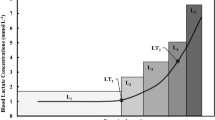Abstract
Detection of the ventilatory threshold during an incremental load exercise test by eye can be difficult. Although various alternative methods employing information other than the ventilation can be used to assist in determining the ventilatory threshold, they rely on underlying assumptions about the physiological basis for the ventilatory threshold. The method presented here (CUSUM) uses only the ventilation data, and therefore avoids such assumptions. Twelve subjects performed a total of 47 incremental exercise tests to exhaustion. Determinations of the ventilatory thresholds made by eye from the ventilation data (mean of three independent observers) were used as a standard for comparison with determinations using the modified V-slope method and the CUSUM method. A mean (SD) difference of 0.6 (2.84) ml·min−1·kg−1 was found between the standard ventilatory thresholds and those determined using the modified V-slope method. A similar comparison between the standard ventilatory thresholds and those determined using the CUSUM method yielded a difference of −0.11 (2.35) ml min−1·kg−1. It was concluded that the CUSUM method was a useful aid for the detection of the ventilatory threshold using the ventilation data alone.
Similar content being viewed by others
References
Bland JM, Altman DG (1986) Statistical methods for assessing agreement between two methods of clinical measurement. Lancet 1:307–310
Caiozzo VJ, Davis JA, Ellis JF, Azus JL, Vandagriff R, Prietto CA, McMaster WC (1982) A comparison of gas exchange indices used to detect the anerobic threshold. J Appl Physiol 53:114–1189
Davis JA, Vodak P, Wilmore JH, Vodak J, Kurtz P (1976) Anaerobic threshold and maximal aerobic power for three modes of exercise. J Appl Physiol 41:544–550
Davis JA, Frank MH, Whipp BJ, Wasserman K (1979) Anaerobic threshold alterations caused by endurance training in middleaged men. J Appl Physiol 46:1039–1046
Gaesser GA, Poole DC, Gardner BP (1984) Dissociation between VO2max and ventilatory threshold responses to endurance training. Eur J Appl Physiol 53:242–247
Hughson RL, Orok CJ, Staudt LE (1984) A high velocity treadmill running test to assess endurance running potential. Int J Sports Med 5:23–25
Mateika JH, Duffin J (1994) Coincidental changes in ventilation and electromyographic activity during consecutive incremental exercise tests. Eur J Appl Physiol 68:54–61
McLellan TM, Cheung KSY, Jacobs I (1991) Incremental test protocol, recovery mode and the individual anaerobic threshold. Int J Sports Med 2:190–195
Orr GW, Green HJ, Hughson RL, Bennett GW (1982) A computer linear regression model to determine ventilatory anaerobic threshold. J Appl Physiol 52:1349–1352
Reinhard U, Muller PH, Schmulling RM (1979) Determination of anaerobic threshold by ventilation equivalent in normal individuals. Respiration 38:36–42
Shepard RJ (1988) PAR-Q, Canadian home fitness test and exercise screening alternatives. Sports Med 5:1985–1995
Sue DY, Wasserman K, Moricca RB, Casaburi R (1988) Metabolic acidosis during exercise in patients with chronic obstructive pulmonary disease; use of the V-slope method for anaerobic determination. Chest 94:931–938
Thomas SG, Cunningham DA, Thompson J, Rechnitzer PA (1985) Exercise training and “ventilatory threshold” in elderly men. Med Sci Sports Exerc 17:667–672
Volkov NI, Shirkovets EA, Borilkevich VE (1975) Assessment of aerobic and anaerobic capacity of athletes in treadmill running tests. Eur J Appl Physiol 34:121–130
Wasserman K (1984) The anaerobic threshold measurement to evaluate exercise performance. Am Rev Respir Dis [Suppl] 129:835–840
Wasserman K, Whipp BJ, Koyal SN, Beaver WL (1973) Anaerobic threshold and respiratory gas exchange during exercise. J Appl Physiol 35:236–243
Wasserman K, Beaver WL, Whipp BJ (1990) Gas exchange theory and the lactic acidosis (anaerobic) threshold. Circulation 81 [Suppl 2]:14–30
Yeh MP, Gardner RM, Adams TD, Yanowitz FG, Crapo RO (1983) “Anaerobic threshold”: problems of determination and validation. J Appl Physiol 55:1178–1186
Author information
Authors and Affiliations
Rights and permissions
About this article
Cite this article
Bischoff, M.M., Duffin, J. An aid to the determination of the ventilatory threshold. Europ. J. Appl. Physiol. 71, 65–70 (1995). https://doi.org/10.1007/BF00511234
Accepted:
Issue Date:
DOI: https://doi.org/10.1007/BF00511234




